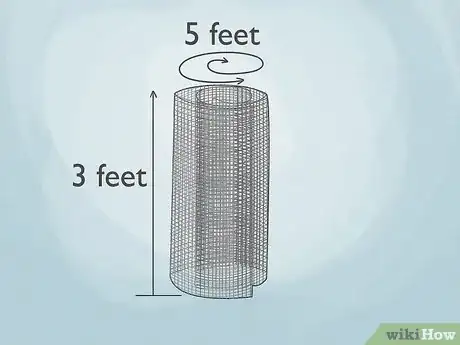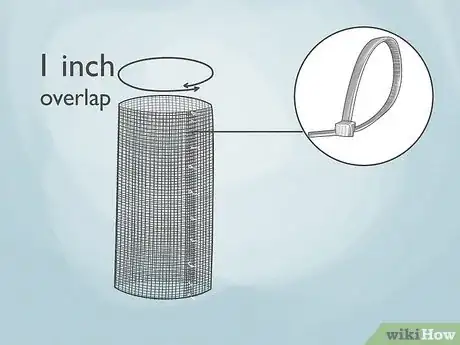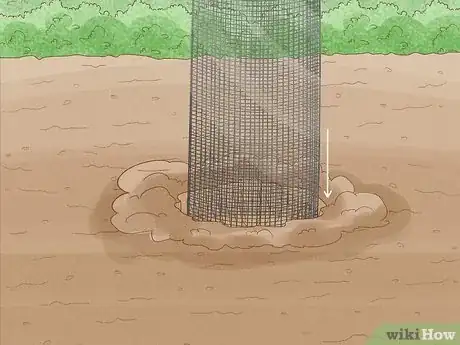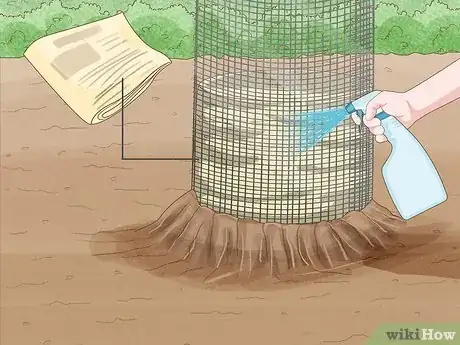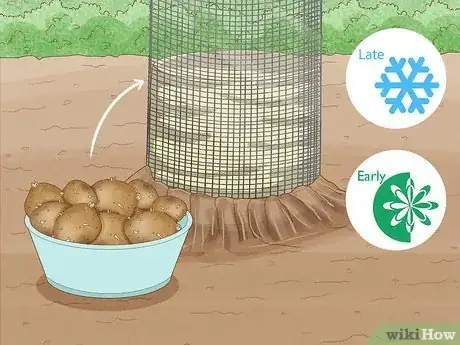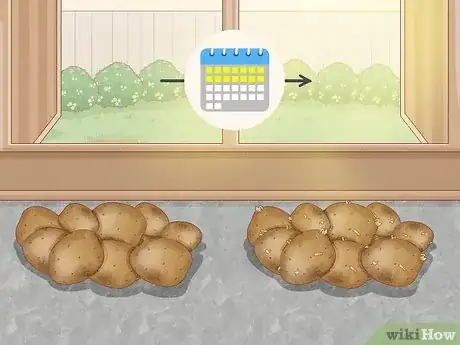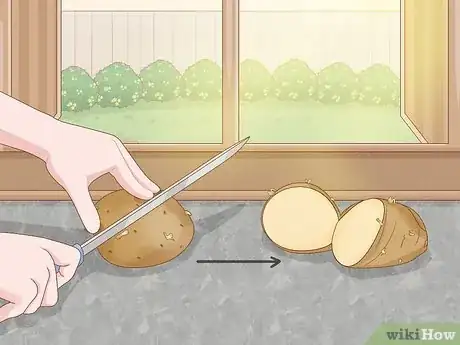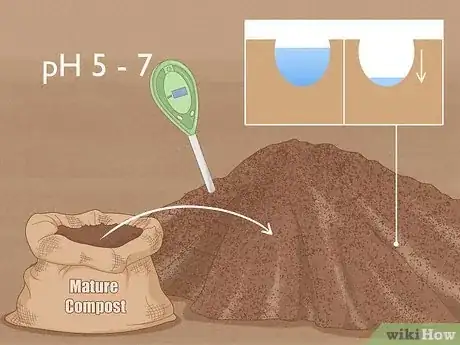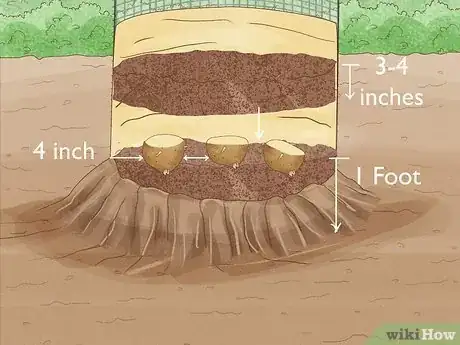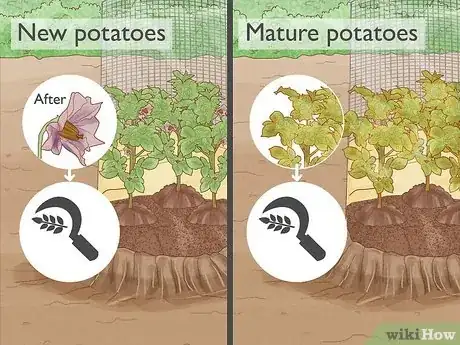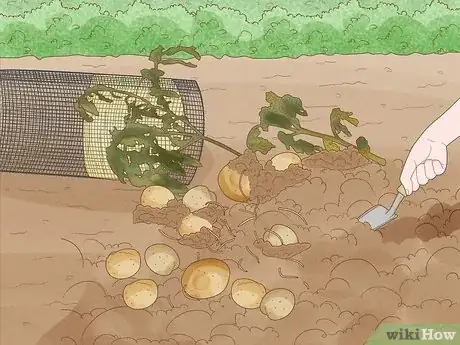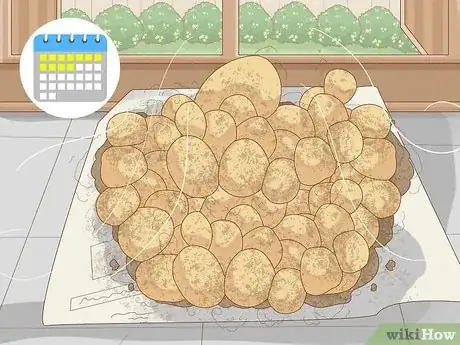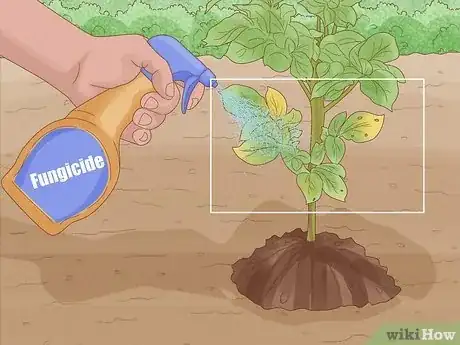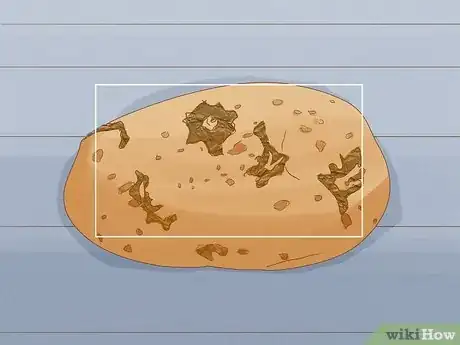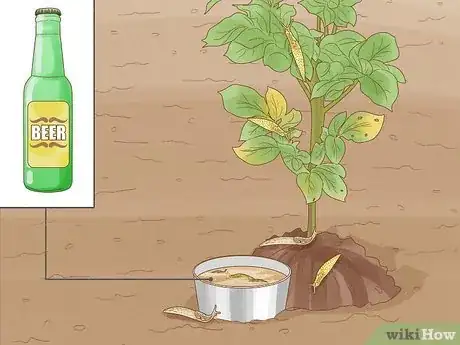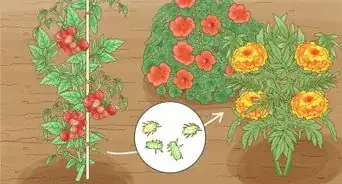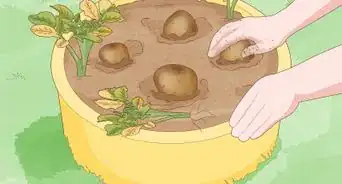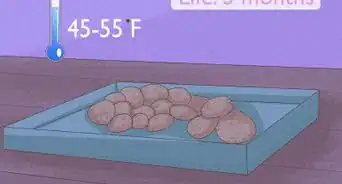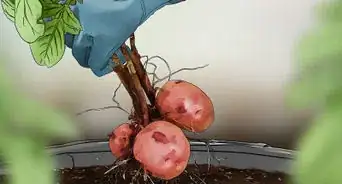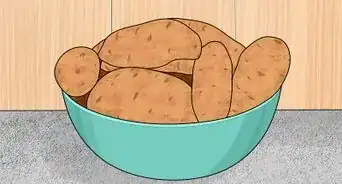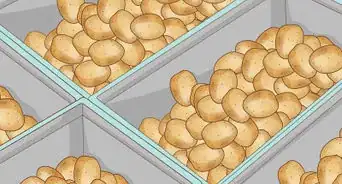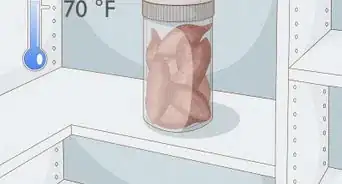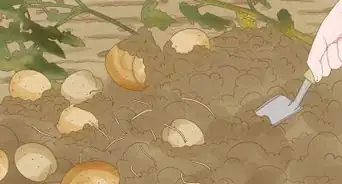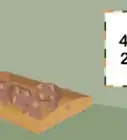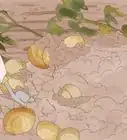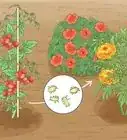This article was co-authored by Lauren Kurtz. Lauren Kurtz is a Naturalist and Horticultural Specialist. Lauren has worked for Aurora, Colorado managing the Water-Wise Garden at Aurora Municipal Center for the Water Conservation Department. She earned a BA in Environmental and Sustainability Studies from Western Michigan University in 2014.
There are 11 references cited in this article, which can be found at the bottom of the page.
wikiHow marks an article as reader-approved once it receives enough positive feedback. In this case, 100% of readers who voted found the article helpful, earning it our reader-approved status.
This article has been viewed 142,374 times.
Potatoes are a versatile, tasty, and easy-to-grow tuber. While growing potatoes in the traditional way can take up a lot of space in the garden, you can also grow them vertically in a tower in a much smaller area. Another benefit of growing potatoes in a cage is that they're easier to water and easier to harvest. For the wire cage, you can either make your own, or purchase a prefabricated tomato cage for even easier planting.
Steps
Making the Cage
-
1Form the cage with wire mesh. To make your potato cage, you'll need flexible but sturdy wire mesh that’s 5 feet (1.5 m) (152 cm) long and 3 feet (0.91 m) (91 cm) tall. Take the length of wire mesh and wrap the ends toward each other to form a cylindrical cage with two open ends.
-
2Secure the ends of the mesh together. When you’ve folded the ends of the cage together, overlap them by about an inch (2.5 cm). Secure the ends together by tying them with twine or fastening them with zip ties. This will prevent the cage from opening up.[3]Advertisement
-
3Find a sunny location for the cage. Potatoes thrive in full sun, so it’s important to pick a bright location for your cage. Choose a location that receives between six and eight hours of full sun every day.[4]
-
4Embed the cage in the soil. When you’ve found the ideal spot for your potatoes, dig a hole in the ground that’s about 6 inches (15 cm) deep and about the same diameter as your cage. Place the cage in the hole and pack the exterior base with extra soil.
- Along with removing weeds and other competition from the area, embedding the cage in the ground will also help to secure it and prevent it from blowing over in the wind. Use wire stakes to secure the cage to the ground if you think blowing over will be an issue.[5]
-
5Line the cage with newspaper. Spray some newspaper with water to get it damp. This will help the paper to stick to the cage. Line the lower half of the inside of the cage with the damp newspaper. This isn't strictly necessary, but the newspaper will keep the soil inside the cage if the openings in the wire mesh are too large.
- You can also use straw to line the cage if you prefer.[6]
Planting the Potatoes
-
1Pick the ideal time to plant. Potatoes prefer cooler weather, so it’s important to plant them in late winter or early spring. The ideal time is two weeks after the last frost. In warmer areas where the ground doesn’t freeze during winter, you can actually plant your potatoes in the late fall.[7]
-
2Sprout the seed potatoes. Some seed potatoes may not yet have sprouts, but you can change that before planting. For seed potatoes that don’t yet have any sprouts, lay them out in a bright room for two weeks prior to planting to encourage sprouting.[8] Make sure the light in the room is indirect to prevent solanine production.
- Seed potatoes are sprouted potatoes that haven't been treated with a sprout inhibitor. Because many eating potatoes from the grocery store have been treated, you won’t be able to grow a new plant from them.
- Solanine is a toxic chemical that potatoes produce when they're exposed to the sun. It appears as a layer of green under the skin.
-
3Cut up large seed potatoes. Larger seed potatoes with lots of sprouts can be cut into smaller portions to maximize plant growth. Make sure each piece has at least two sprouts. After cutting, let the potatoes rest for two days in a dry and well-ventilated location. This will give the skins time to heal, and prevent the potatoes from rotting in the ground.[9]
-
4Mix the soil. Potatoes do best in well-draining, sandy soil that’s slightly acidic, with a pH between 5.0 and 7.0. To enhance the nutrients and acidity of your soil, mix it with equal parts mature compost or aged manure. Mixing the soil like this will also loosen it up, which is ideal for potatoes.[10]
-
5Plant the seed potatoes in the bottom of the cage. Fill the bottom of the cage with about a foot (30 cm) of pre-mixed potato soil. Place your seed potatoes into the soil with the sprouts facing upward. Space the potatoes 4 inches (10 cm) from each other and from the sides of the cage.[11] Cover the seed potatoes with an additional 3 to 4 inches (7.6 to 10 cm) of soil.
-
6Water the newly planted potatoes and keep the soil moist. As soon as the potatoes are in the cage, water them generously. As the potatoes grow, provide them with at least an inch of water each week to keep the soil moist, but not wet.[12]
- Potatoes in cages can dry out more quickly than those in the ground, so check the soil regularly for moisture.
Growing and Harvesting the Potatoes
-
1Hill the soil around the growing plants. Because potatoes that are exposed to sunlight will produce solanine, it’s important to hill the potatoes. To do this, wait until the plants reach about 6 inches (15 cm), and then add an extra 2 inches (5 cm) of soil to the cage.[13]
- Continue hilling the potatoes whenever the plants grow an additional 6 inches (15 cm).
-
2Decide if you want new or mature potatoes. New potatoes are ones that are harvested before they're fully mature. New potatoes are ready for harvest after the plant stops flowering. Mature potatoes are ones that are left to fully develop, and they’ll be ready to harvest after the foliage dies back and turns brown.[14]
- For new potatoes, harvest after the last of the flowers die.
- For mature potatoes, wait an additional two to three weeks after the foliage dies before harvesting.
-
3Take the cage apart to harvest the potatoes. When your potatoes are ready for harvest, lay a tarp on the ground beside the cage. Use scissors to cut the twine or zip ties holding the cage together. Gently push the cage over onto the tarp to spill the soil and potatoes. Dig through the soil to retrieve all the potatoes that have grown.[15]
- When you’ve harvested the potatoes, brush off the wire mesh and store it somewhere dry. You can reuse the mesh to make another cage.
-
4Cure mature potatoes before storing. To extend the shelf life of your potatoes, it’s important to cure them, which means allowing the skins to toughen. Move the potatoes to a cool, dry, and ventilated location to cure for 10 to 14 days.[16]
- New potatoes shouldn’t be cured, as they should be eaten within a few days of the harvest.
-
5Store your extra potatoes. Brush the dirt from your cured potatoes with a cloth or soft brush. Fill paper or burlap bags with the cleaned potatoes, and transfer them to a dry, cool, and dark place, such as a root cellar, for long-term storage.[17]
Treating Pests and Diseases
-
1Look for dark blotches on leaves. This may be blight, which is a disease that can cause your plant and the potatoes to rot. If left untreated, it will also spread to your other plants. Blight usually happens during the warm humid times of the summer.
- Remove all diseased foliage.
- Treat the plant with a fungicide that is sprayed on the leaves.[18]
-
2Check for scabs that look like corky blemishes on the potato skins. This is called potato scab and won't affect the taste of the potatoes. However, it will affect the storage potential of your potatoes, so you may not be able to store your crop for long. It is generally caused by poor soils and is best treated by amending the soil with organic matter and keeping potatoes regularly watered during the season.[19]
-
3Watch for slugs. Slugs will eat the foliage and the tubers of the potato plant. You should be able to see the slugs on the plant, and their slime trails will be noticeable on the leaves. Bury a tuna can level with the soil and pour beer into the can, this will attract and drown the slugs.[20]
- Slug pellets or Sluggo can also be used to kill slugs.
Expert Q&A
-
QuestionCan you grow potatoes in straw?
 Lauren KurtzLauren Kurtz is a Naturalist and Horticultural Specialist. Lauren has worked for Aurora, Colorado managing the Water-Wise Garden at Aurora Municipal Center for the Water Conservation Department. She earned a BA in Environmental and Sustainability Studies from Western Michigan University in 2014.
Lauren KurtzLauren Kurtz is a Naturalist and Horticultural Specialist. Lauren has worked for Aurora, Colorado managing the Water-Wise Garden at Aurora Municipal Center for the Water Conservation Department. She earned a BA in Environmental and Sustainability Studies from Western Michigan University in 2014.
Professional Gardener Potatoes can be grown in straw but would benefit from some soil in addition to the straw.
Potatoes can be grown in straw but would benefit from some soil in addition to the straw. -
QuestionHow do you grow potatoes in tires?
 Lauren KurtzLauren Kurtz is a Naturalist and Horticultural Specialist. Lauren has worked for Aurora, Colorado managing the Water-Wise Garden at Aurora Municipal Center for the Water Conservation Department. She earned a BA in Environmental and Sustainability Studies from Western Michigan University in 2014.
Lauren KurtzLauren Kurtz is a Naturalist and Horticultural Specialist. Lauren has worked for Aurora, Colorado managing the Water-Wise Garden at Aurora Municipal Center for the Water Conservation Department. She earned a BA in Environmental and Sustainability Studies from Western Michigan University in 2014.
Professional Gardener The same way you would grow them in a pot or potato bag. Plant the potatoes and once they grow above the soil level, add more soil or mound the potatoes. Add additional tires on top of the original one as needed.
The same way you would grow them in a pot or potato bag. Plant the potatoes and once they grow above the soil level, add more soil or mound the potatoes. Add additional tires on top of the original one as needed.
References
- ↑ http://www.myfrugalhome.com/how-to-grow-potatoes-in-a-cage/
- ↑ http://living.thebump.com/grow-potatoes-tomato-cages-7468.html
- ↑ https://www.fieldandfeast.com/grow-something/growing-potatoes-in-cages/
- ↑ https://www.fieldandfeast.com/grow-something/growing-potatoes-in-cages/
- ↑ https://www.fieldandfeast.com/grow-something/growing-potatoes-in-cages/
- ↑ http://artofnaturalliving.com/2011/05/01/the-lazy-persons-potato-garden/
- ↑ https://www.almanac.com/plant/potatoes
- ↑ http://blog.seedsavers.org/blog/tips-for-growing-potatoes
- ↑ http://commonsensehome.com/growing-potatoes-easy-way/
- ↑ https://www.thompson-morgan.com/how-to-grow-potatoes-in-the-ground
- ↑ http://living.thebump.com/grow-potatoes-tomato-cages-7468.html
- ↑ http://www.myfrugalhome.com/how-to-grow-potatoes-in-a-cage/
- ↑ http://www.myfrugalhome.com/how-to-grow-potatoes-in-a-cage/
- ↑ http://artofnaturalliving.com/2011/05/01/the-lazy-persons-potato-garden/
- ↑ http://commonsensehome.com/growing-potatoes-easy-way/
- ↑ https://www.fieldandfeast.com/grow-something/growing-potatoes-in-cages/
- ↑ https://www.thompson-morgan.com/how-to-grow-potatoes-in-the-ground
- ↑ https://www.growveg.com/guides/how-to-avoid-potato-blight/
- ↑ https://www.gardeningknowhow.com/edible/vegetables/potato/treating-scab-in-potatoes.htm
- ↑ http://www.gardenmyths.com/how-to-get-rid-slugs-with-beer/
